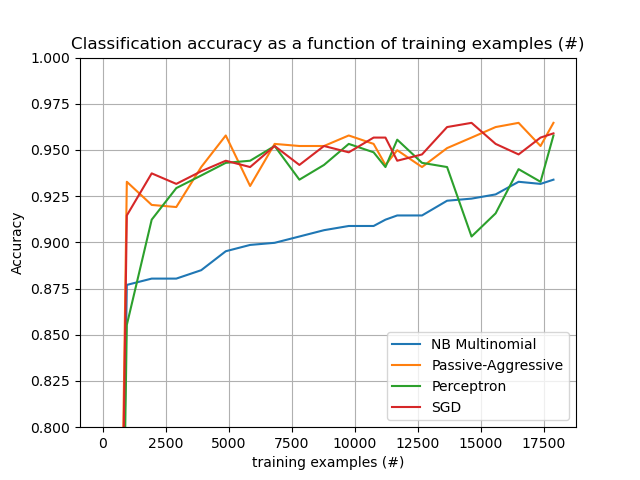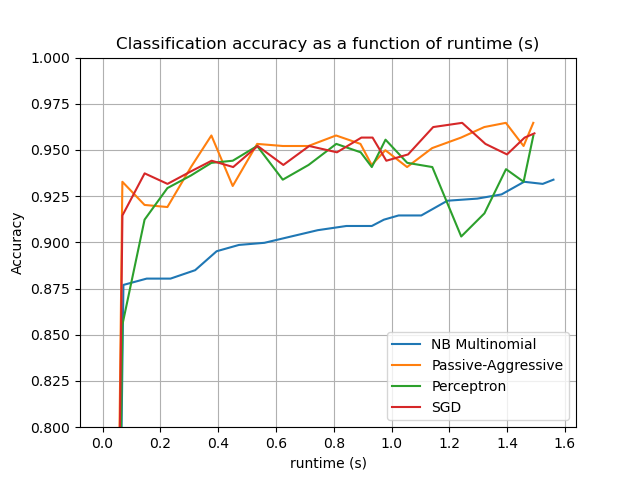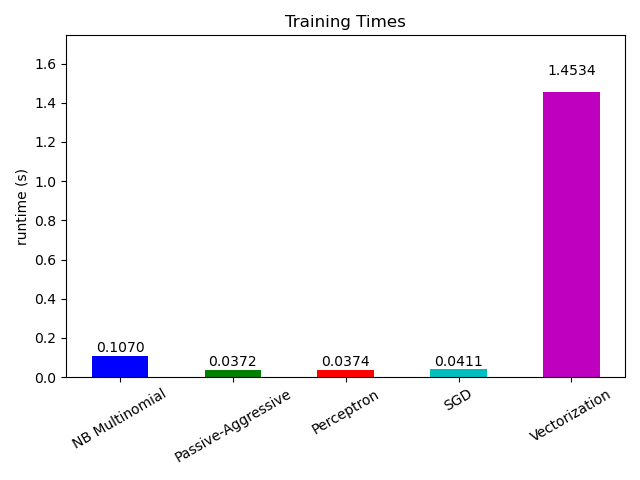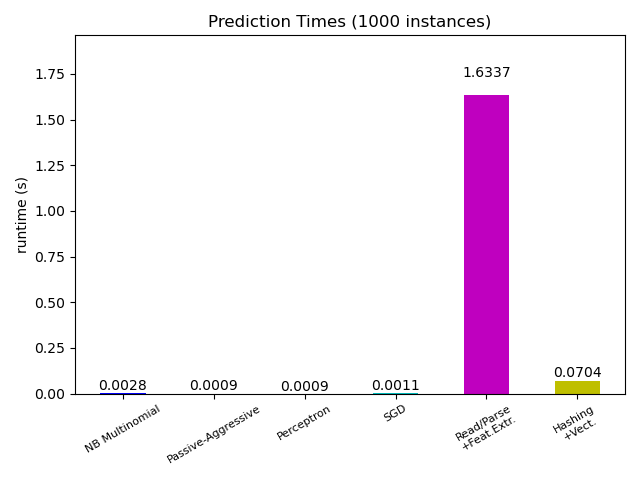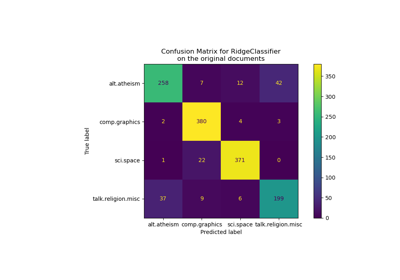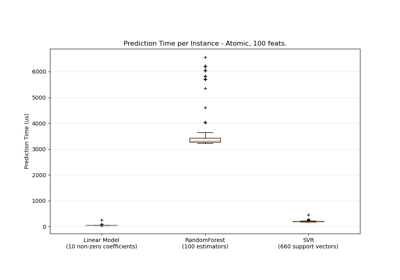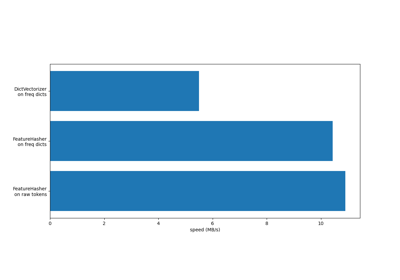注意
Go to the end to download the full example code or to run this example in your browser via JupyterLite or Binder.
文本数据的核外分类#
此示例展示了如何使用scikit-learn进行核外分类:从无法完全载入主内存的数据中进行学习。我们使用支持 partial_fit 方法的在线分类器,该分类器将分批接收示例。为了确保特征空间随时间保持不变,我们利用 HashingVectorizer 将每个示例投影到相同的特征空间中。这在文本分类的情况下特别有用,因为新特征(单词)可能会出现在每个批次中。
# Authors: The scikit-learn developers
# SPDX-License-Identifier: BSD-3-Clause
import itertools
import re
import sys
import tarfile
import time
from hashlib import sha256
from html.parser import HTMLParser
from pathlib import Path
from urllib.request import urlretrieve
import matplotlib.pyplot as plt
import numpy as np
from matplotlib import rcParams
from sklearn.datasets import get_data_home
from sklearn.feature_extraction.text import HashingVectorizer
from sklearn.linear_model import Perceptron, SGDClassifier
from sklearn.naive_bayes import MultinomialNB
def _not_in_sphinx():
# Hack to detect whether we are running by the sphinx builder
return "__file__" in globals()
主要部分#
创建向量化器并将特征数量限制在合理的范围内
vectorizer = HashingVectorizer(
decode_error="ignore", n_features=2**18, alternate_sign=False
)
# Iterator over parsed Reuters SGML files.
data_stream = stream_reuters_documents()
# We learn a binary classification between the "acq" class and all the others.
# "acq" was chosen as it is more or less evenly distributed in the Reuters
# files. For other datasets, one should take care of creating a test set with
# a realistic portion of positive instances.
all_classes = np.array([0, 1])
positive_class = "acq"
# Here are some classifiers that support the `partial_fit` method
partial_fit_classifiers = {
"SGD": SGDClassifier(max_iter=5),
"Perceptron": Perceptron(),
"NB Multinomial": MultinomialNB(alpha=0.01),
"Passive-Aggressive": SGDClassifier(
loss="hinge", penalty=None, learning_rate="pa1", eta0=1.0
),
}
def get_minibatch(doc_iter, size, pos_class=positive_class):
"""Extract a minibatch of examples, return a tuple X_text, y.
Note: size is before excluding invalid docs with no topics assigned.
"""
data = [
("{title}\n\n{body}".format(**doc), pos_class in doc["topics"])
for doc in itertools.islice(doc_iter, size)
if doc["topics"]
]
if not len(data):
return np.asarray([], dtype=int), np.asarray([], dtype=int)
X_text, y = zip(*data)
return X_text, np.asarray(y, dtype=int)
def iter_minibatches(doc_iter, minibatch_size):
"""Generator of minibatches."""
X_text, y = get_minibatch(doc_iter, minibatch_size)
while len(X_text):
yield X_text, y
X_text, y = get_minibatch(doc_iter, minibatch_size)
# test data statistics
test_stats = {"n_test": 0, "n_test_pos": 0}
# First we hold out a number of examples to estimate accuracy
n_test_documents = 1000
tick = time.time()
X_test_text, y_test = get_minibatch(data_stream, 1000)
parsing_time = time.time() - tick
tick = time.time()
X_test = vectorizer.transform(X_test_text)
vectorizing_time = time.time() - tick
test_stats["n_test"] += len(y_test)
test_stats["n_test_pos"] += sum(y_test)
print("Test set is %d documents (%d positive)" % (len(y_test), sum(y_test)))
def progress(cls_name, stats):
"""Report progress information, return a string."""
duration = time.time() - stats["t0"]
s = "%20s classifier : \t" % cls_name
s += "%(n_train)6d train docs (%(n_train_pos)6d positive) " % stats
s += "%(n_test)6d test docs (%(n_test_pos)6d positive) " % test_stats
s += "accuracy: %(accuracy).3f " % stats
s += "in %.2fs (%5d docs/s)" % (duration, stats["n_train"] / duration)
return s
cls_stats = {}
for cls_name in partial_fit_classifiers:
stats = {
"n_train": 0,
"n_train_pos": 0,
"accuracy": 0.0,
"accuracy_history": [(0, 0)],
"t0": time.time(),
"runtime_history": [(0, 0)],
"total_fit_time": 0.0,
}
cls_stats[cls_name] = stats
get_minibatch(data_stream, n_test_documents)
# Discard test set
# We will feed the classifier with mini-batches of 1000 documents; this means
# we have at most 1000 docs in memory at any time. The smaller the document
# batch, the bigger the relative overhead of the partial fit methods.
minibatch_size = 1000
# Create the data_stream that parses Reuters SGML files and iterates on
# documents as a stream.
minibatch_iterators = iter_minibatches(data_stream, minibatch_size)
total_vect_time = 0.0
# Main loop : iterate on mini-batches of examples
for i, (X_train_text, y_train) in enumerate(minibatch_iterators):
tick = time.time()
X_train = vectorizer.transform(X_train_text)
total_vect_time += time.time() - tick
for cls_name, cls in partial_fit_classifiers.items():
tick = time.time()
# update estimator with examples in the current mini-batch
cls.partial_fit(X_train, y_train, classes=all_classes)
# accumulate test accuracy stats
cls_stats[cls_name]["total_fit_time"] += time.time() - tick
cls_stats[cls_name]["n_train"] += X_train.shape[0]
cls_stats[cls_name]["n_train_pos"] += sum(y_train)
tick = time.time()
cls_stats[cls_name]["accuracy"] = cls.score(X_test, y_test)
cls_stats[cls_name]["prediction_time"] = time.time() - tick
acc_history = (cls_stats[cls_name]["accuracy"], cls_stats[cls_name]["n_train"])
cls_stats[cls_name]["accuracy_history"].append(acc_history)
run_history = (
cls_stats[cls_name]["accuracy"],
total_vect_time + cls_stats[cls_name]["total_fit_time"],
)
cls_stats[cls_name]["runtime_history"].append(run_history)
if i % 3 == 0:
print(progress(cls_name, cls_stats[cls_name]))
if i % 3 == 0:
print("\n")
Test set is 878 documents (108 positive)
SGD classifier : 962 train docs ( 132 positive) 878 test docs ( 108 positive) accuracy: 0.915 in 0.53s ( 1816 docs/s)
Perceptron classifier : 962 train docs ( 132 positive) 878 test docs ( 108 positive) accuracy: 0.855 in 0.53s ( 1808 docs/s)
NB Multinomial classifier : 962 train docs ( 132 positive) 878 test docs ( 108 positive) accuracy: 0.877 in 0.54s ( 1781 docs/s)
Passive-Aggressive classifier : 962 train docs ( 132 positive) 878 test docs ( 108 positive) accuracy: 0.933 in 0.54s ( 1772 docs/s)
SGD classifier : 3911 train docs ( 517 positive) 878 test docs ( 108 positive) accuracy: 0.938 in 1.50s ( 2606 docs/s)
Perceptron classifier : 3911 train docs ( 517 positive) 878 test docs ( 108 positive) accuracy: 0.936 in 1.50s ( 2602 docs/s)
NB Multinomial classifier : 3911 train docs ( 517 positive) 878 test docs ( 108 positive) accuracy: 0.885 in 1.51s ( 2589 docs/s)
Passive-Aggressive classifier : 3911 train docs ( 517 positive) 878 test docs ( 108 positive) accuracy: 0.941 in 1.51s ( 2585 docs/s)
SGD classifier : 6821 train docs ( 891 positive) 878 test docs ( 108 positive) accuracy: 0.952 in 2.47s ( 2759 docs/s)
Perceptron classifier : 6821 train docs ( 891 positive) 878 test docs ( 108 positive) accuracy: 0.952 in 2.47s ( 2757 docs/s)
NB Multinomial classifier : 6821 train docs ( 891 positive) 878 test docs ( 108 positive) accuracy: 0.900 in 2.48s ( 2748 docs/s)
Passive-Aggressive classifier : 6821 train docs ( 891 positive) 878 test docs ( 108 positive) accuracy: 0.953 in 2.48s ( 2745 docs/s)
SGD classifier : 9759 train docs ( 1276 positive) 878 test docs ( 108 positive) accuracy: 0.949 in 3.43s ( 2844 docs/s)
Perceptron classifier : 9759 train docs ( 1276 positive) 878 test docs ( 108 positive) accuracy: 0.953 in 3.43s ( 2842 docs/s)
NB Multinomial classifier : 9759 train docs ( 1276 positive) 878 test docs ( 108 positive) accuracy: 0.909 in 3.44s ( 2836 docs/s)
Passive-Aggressive classifier : 9759 train docs ( 1276 positive) 878 test docs ( 108 positive) accuracy: 0.958 in 3.44s ( 2834 docs/s)
SGD classifier : 11680 train docs ( 1499 positive) 878 test docs ( 108 positive) accuracy: 0.944 in 4.24s ( 2751 docs/s)
Perceptron classifier : 11680 train docs ( 1499 positive) 878 test docs ( 108 positive) accuracy: 0.956 in 4.25s ( 2750 docs/s)
NB Multinomial classifier : 11680 train docs ( 1499 positive) 878 test docs ( 108 positive) accuracy: 0.915 in 4.25s ( 2745 docs/s)
Passive-Aggressive classifier : 11680 train docs ( 1499 positive) 878 test docs ( 108 positive) accuracy: 0.950 in 4.26s ( 2743 docs/s)
SGD classifier : 14625 train docs ( 1865 positive) 878 test docs ( 108 positive) accuracy: 0.965 in 5.24s ( 2792 docs/s)
Perceptron classifier : 14625 train docs ( 1865 positive) 878 test docs ( 108 positive) accuracy: 0.903 in 5.24s ( 2791 docs/s)
NB Multinomial classifier : 14625 train docs ( 1865 positive) 878 test docs ( 108 positive) accuracy: 0.924 in 5.25s ( 2787 docs/s)
Passive-Aggressive classifier : 14625 train docs ( 1865 positive) 878 test docs ( 108 positive) accuracy: 0.957 in 5.25s ( 2785 docs/s)
SGD classifier : 17360 train docs ( 2179 positive) 878 test docs ( 108 positive) accuracy: 0.957 in 6.13s ( 2831 docs/s)
Perceptron classifier : 17360 train docs ( 2179 positive) 878 test docs ( 108 positive) accuracy: 0.933 in 6.13s ( 2830 docs/s)
NB Multinomial classifier : 17360 train docs ( 2179 positive) 878 test docs ( 108 positive) accuracy: 0.932 in 6.14s ( 2827 docs/s)
Passive-Aggressive classifier : 17360 train docs ( 2179 positive) 878 test docs ( 108 positive) accuracy: 0.952 in 6.14s ( 2826 docs/s)
绘制结果#
该图表表示分类器的学习曲线:分类精度在迷你批次过程中的演变。精度是在前1000个样本上测量的,这些样本被保留作为验证集。
为了限制内存消耗,我们在将示例馈送给学习器之前,将示例排队到固定数量。
def plot_accuracy(x, y, x_legend):
"""Plot accuracy as a function of x."""
x = np.array(x)
y = np.array(y)
plt.title("Classification accuracy as a function of %s" % x_legend)
plt.xlabel("%s" % x_legend)
plt.ylabel("Accuracy")
plt.grid(True)
plt.plot(x, y)
rcParams["legend.fontsize"] = 10
cls_names = list(sorted(cls_stats.keys()))
# Plot accuracy evolution
plt.figure()
for _, stats in sorted(cls_stats.items()):
# Plot accuracy evolution with #examples
accuracy, n_examples = zip(*stats["accuracy_history"])
plot_accuracy(n_examples, accuracy, "training examples (#)")
ax = plt.gca()
ax.set_ylim((0.8, 1))
plt.legend(cls_names, loc="best")
plt.figure()
for _, stats in sorted(cls_stats.items()):
# Plot accuracy evolution with runtime
accuracy, runtime = zip(*stats["runtime_history"])
plot_accuracy(runtime, accuracy, "runtime (s)")
ax = plt.gca()
ax.set_ylim((0.8, 1))
plt.legend(cls_names, loc="best")
# Plot fitting times
plt.figure()
fig = plt.gcf()
cls_runtime = [stats["total_fit_time"] for cls_name, stats in sorted(cls_stats.items())]
cls_runtime.append(total_vect_time)
cls_names.append("Vectorization")
bar_colors = ["b", "g", "r", "c", "m", "y"]
ax = plt.subplot(111)
rectangles = plt.bar(range(len(cls_names)), cls_runtime, width=0.5, color=bar_colors)
ax.set_xticks(np.linspace(0, len(cls_names) - 1, len(cls_names)))
ax.set_xticklabels(cls_names, fontsize=10)
ymax = max(cls_runtime) * 1.2
ax.set_ylim((0, ymax))
ax.set_ylabel("runtime (s)")
ax.set_title("Training Times")
def autolabel(rectangles):
"""attach some text vi autolabel on rectangles."""
for rect in rectangles:
height = rect.get_height()
ax.text(
rect.get_x() + rect.get_width() / 2.0,
1.05 * height,
"%.4f" % height,
ha="center",
va="bottom",
)
plt.setp(plt.xticks()[1], rotation=30)
autolabel(rectangles)
plt.tight_layout()
plt.show()
# Plot prediction times
plt.figure()
cls_runtime = []
cls_names = list(sorted(cls_stats.keys()))
for cls_name, stats in sorted(cls_stats.items()):
cls_runtime.append(stats["prediction_time"])
cls_runtime.append(parsing_time)
cls_names.append("Read/Parse\n+Feat.Extr.")
cls_runtime.append(vectorizing_time)
cls_names.append("Hashing\n+Vect.")
ax = plt.subplot(111)
rectangles = plt.bar(range(len(cls_names)), cls_runtime, width=0.5, color=bar_colors)
ax.set_xticks(np.linspace(0, len(cls_names) - 1, len(cls_names)))
ax.set_xticklabels(cls_names, fontsize=8)
plt.setp(plt.xticks()[1], rotation=30)
ymax = max(cls_runtime) * 1.2
ax.set_ylim((0, ymax))
ax.set_ylabel("runtime (s)")
ax.set_title("Prediction Times (%d instances)" % n_test_documents)
autolabel(rectangles)
plt.tight_layout()
plt.show()
脚本总运行时间: (0 minutes 6.937 seconds)
相关示例
